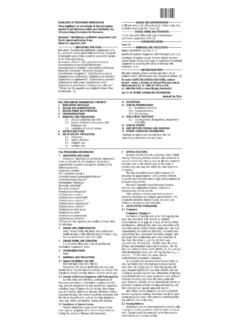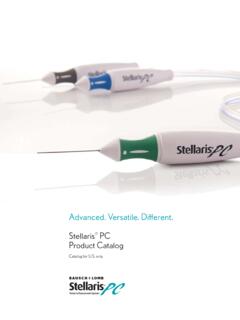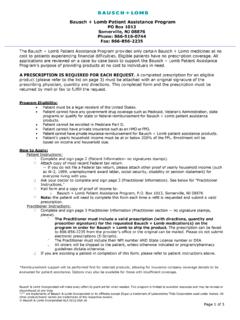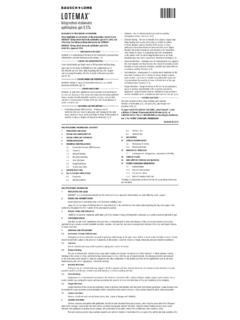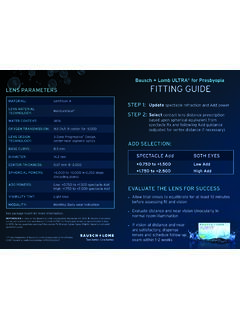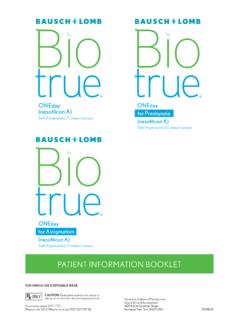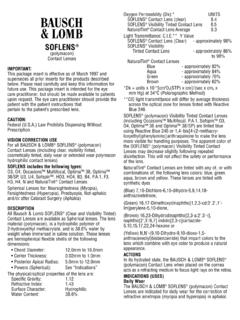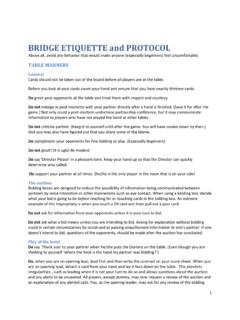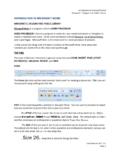Transcription of PATIENT INFORMATION BOOKLET - Lomb
1 Bausch & Lomb Incorporated 1400 North Goodman Street Rochester, NY 14609 USA Printed in the USA Rev. 2018-07 8161702 PATIENT INFORMATION BOOKLETATTENTION: Read and save the enclosed : Federal law restricts this device to sale by or on the order of a licensed INFORMATION BOOKLET TABLE OF CONTENTS Introduction ..4 Wearing Restrictions and Indications ..4 Contraindications (Reasons Not To Use) ..5 Warnings ..5 Precautions ..5 Adverse Reactions (Problems and What To Do) ..7 Personal Cleanliness and Lens Handling ..7 Preparing the Lens for Handling the Lenses ..7 Placing the Lens on the Centering the Lens ..8 Removing the Lens ..9 Lens Wearing Schedules ..9 Caring for Your Lenses (Cleaning, Rinsing, Disinfecting, Enzyming, Storage and Rewetting/Lubricating) ..9 Soaking and Storing Rub and Rinse Time ..9 Lens Case Care ..10 Water Activity ..10 Discard Date on the Solution Bottle ..10 Basic Instructions ..10 Chemical (Not Heat) Disinfection.
2 10 Lens Deposits and Use of Enzymatic Cleaning Procedure ..10 Care for a Sticking (Nonmoving) Lens ..11 Care for a Dried Out (Dehydrated) Lens ..11 Care Product Chart ..11 Instructions for the Monovision or Multi-Focal Wearer ..12 Personal Wearing Schedule Record ..13 Check-Up Visits ..14 Visit Schedule ..14 Eye Care Practitioner INFORMATION ..14 Glossary of Medical Terms ..15 Symbol Reference Guide ..154 INTRODUCTIONThe instructions in this BOOKLET apply to the Bausch + Lomb ULTRA (samfilcon A) Contact Lenses. If you have received or are considering another brand of contact lenses, do not use this BOOKLET . Ask your eye care practitioner for the PATIENT BOOKLET or instructions that apply to your brand or type of contact lenses. For Bausch + Lomb ULTRA (samfilcon A) Contact Lenses, it is essential to your safety that you read and understand the INFORMATION and instructions in this BOOKLET , and have your eye care practitioner answer any questions, both before and after you receive contact contact lenses is different from wearing eyeglasses.
3 Because they are worn directly on your eyes, contact lenses affect the way in which your eyes function. These effects tend to increase with the length of time that the lenses remain on your eyes between removals. Although the great majority of people successfully wear contact lenses without problems, before you decide whether to begin or to continue wearing contact lenses for daily wear, you should discuss with your eye care practitioner the effects of contact lenses on your eyes and the risks associated with wearing contact lenses, which are greater with continuous wear contact lens use. You also should read the sections of this BOOKLET entitled WARNINGS, ADVERSE REACTIONS (PROBLEMS AND WHAT TO DO), PRECAUTIONS and WEARING RESTRICTIONS AND INDICATIONS. Ask your eye care practitioner to explain anything that you do not understand, including any additional restrictions which may be given to you by your eye care practitioner. You also need to remember that soft contact lenses, including those covered by this BOOKLET , are made of a type of plastic that absorbs liquids, vapors, and small particles, and, for some people, may collect deposits from your natural eye fluids.
4 Therefore, you should strictly follow the instructions contained in the sections of this BOOKLET entitled PERSONAL CLEANLINESS AND LENS HANDLING, as well as the written INFORMATION leaflets accompanying the lens care products that you buy and any other instructions given to you by your eye care practitioner. Any failure to follow these instructions and the wearing restrictions will increase the chances of contamination, damage to the lenses, or a build-up of deposits on the lenses, which can lead to serious, sight-threatening eye infections and to your prescribed wearing and replacement schedule, and regular check-up visits to your eye care practitioner are also necessary for the proper and safe use of contact is important to not wear your lenses longer than recommended by your eye care practitioner since doing so increases the risk of adverse are provided in the back of this BOOKLET for you to record your personal wearing schedule and schedule of follow-up visits.
5 Soft contact lenses generally are comfortable from the beginning. Therefore, be sure to follow the wearing schedule prescribed for you, and do not wear your lenses for longer periods than your prescribed wearing schedule simply because they remain comfortable and you are not experiencing a problem. Only your eye care practitioner, through a professional examination, can determine how your eyes are reacting to the contact lenses and whether there are any early signs of possible problems or symptoms should occur, immediately remove your lenses and follow the steps described in the section of this BOOKLET entitled WARNINGS and ADVERSE REACTIONS (PROBLEMS AND WHAT TO DO). (Refer to GLOSSARY OF MEDICAL TERMS for description of medical terms used in this BOOKLET ). Prompt attention to problems is essential and may require immediate professional , when wearing soft contact lenses your eyes should look and feel good, and your vision should be RESTRICTIONS AND INDICATIONSSINGLE VISION SPHERICAL (SVS) VISION CORRECTIONThe Bausch + Lomb ULTRA (samfilcon A) Contact Lens is indicated for daily wear or extended wear for up to 7 days between removals for cleaning and disinfection or disposal of the lens, as recommended by the eye care practitioner.
6 The lens is indicated for the correction of refractive ametropia (myopia and hyperopia) in aphakic and/or not-aphakic persons with non-diseased eyes, exhibiting astigmatism of diopters or less, that does not interfere with visual VISION CORRECTION The Bausch + Lomb ULTRA (samfilcon A) Contact Lens For Presbyopia is indicated for daily wear or extended wear for up to 7 days between removals for cleaning and disinfection or disposal of the lens, as recommended by the eye care practitioner. The lens is indicated for the correction of refractive ametropia (myopia, hyperopia and astigmatism) and presbyopia in aphakic and/or not-aphakic persons with non-diseased eyes, exhibiting astigmatism of diopters or less, that does not interfere with visual acuity. The lens may be prescribed for add powers ranging from + D to + VISION CORRECTION The Bausch + Lomb ULTRA (samfilcon A) Contact Lens for Astigmatism is indicated for daily wear or extended wear for up to 7 days between removals for cleaning and disinfection or disposal of the lens, as recommended by the eye care practitioner.
7 The lens is indicated for the correction of refractive ametropia (myopia, hyperopia and astigmatism) in aphakic and/or not-aphakic persons with non-diseased eyes, exhibiting astigmatism up to diopters. FREQUENT/PLANNED REPLACEMENT WEARWhen prescribed for Frequent/Planned Replacement Wear, the Bausch + Lomb ULTRA (samfilcon A) Contact Lens is to be cleaned, rinsed and disinfected each time it is removed from the PATIENT s eye and discarded after the recommended wearing period prescribed by the eye care practitioner. The lens may be disinfected using a chemical disinfection WEARWhen prescribed for Disposable Wear, the Bausch + Lomb ULTRA (samfilcon A) Contact Lens is to be discarded after each RESTRICTIONSThe Bausch + Lomb ULTRA (samfilcon A) Contact Lenses described in this BOOKLET should be removed from your eyes for routine cleaning and disinfecting as prescribed by your eye care practitioner. For extended wear, once the lenses are removed, your eyes should have a rest without lens wear for at least one overnight, as recommended by your eye care practitioner.
8 Your eye care practitioner will tell you how long to rest your eyes in between wearing periods and will also recommend a replacement period and appropriate lens care (REASONS NOT TO USE)DO NOT USE these lenses when any of the following conditions exist: Acute and subacute inflammation or infection of the anterior chamber of the eye Any eye disease, injury, or abnormality that affects the cornea, conjunctiva, or eyelids Severe insufficiency of lacrimal secretion (dry eyes) Corneal hypoesthesia (reduced corneal sensitivity) Any systemic disease that may affect the eye or be exaggerated by wearing contact lenses Allergic reactions of ocular surfaces or adnexa (surrounding tissue) that may be induced or exaggerated by wearing contact lenses or use of contact lens solutions Allergy to any ingredient, such as mercury or Thimerosal, in a solution which is to be used to care for Bausch + Lomb ULTRA (samfilcon A) Contact Lenses Any active corneal infection (bacterial, fungal, or viral) If eyes become red or irritatedWARNINGSYou should be aware of and fully discuss with your eye care practitioner the following warnings pertaining to contact lens wear.
9 Problems with contact lenses and lens care products could result in serious injury to your eye. It is essential that you follow your eye care practitioner s direction and all labeling instructions for proper use of lenses and lens care products, including the lens case. Eye problems, including corneal ulcers, can develop rapidly and lead to loss of vision. Strict compliance with your lens care regimen including cleaning of the lens case, wearing restrictions, wearing schedule, and follow-up visit schedule must be followed. Daily wear lenses are not indicated for overnight wear, and you should not wear lenses while sleeping. Clinical studies have shown that the risk of serious adverse reactions is increased when contact lenses are worn overnight. Studies have shown that contact lens wearers who are smokers have a higher incidence of adverse reactions than nonsmokers. If you experience eye discomfort, excessive tearing, vision changes, or redness of the eye, you should immediately remove lenses and promptly contact your eye care WEAR The risk of microbial keratitis has been shown to be greater among users of continuous wear contact lenses than among users of daily wear contact researchers believe that these complications are caused by one or more of the following: a weakening of the cornea s resistance to infections, particularly during a closed-eye condition, as a result of hypoxia; an eye environment which is somewhat more conducive to the growth of bacteria and other microorganisms, particularly when a regular periodic lens removal and disinfecting or disposal schedule has not been adhered to by the PATIENT ; improper lens disinfection or cleaning by the PATIENT ; contamination of lens care products; poor personal hygiene by the PATIENT ; PATIENT unsuitability to the particular lens or wearing schedule.
10 Accumulation of lens deposits; damage to the lens; improper fitting; length of wearing time; and the presence of ocular debris or environmental the great majority of patients successfully wear contact lenses, continuous wear of lenses also is reported to be associated with a higher incidence and degree of epithelial microcysts and infiltrates, and endothelial polymegathism, which require consideration of discontinuation or restriction of continuous wear. The epithelial conditions are reversible upon discontinuation of continuous reversibility of endothelial effects of contact lens wear has not been conclusively established. As a result, practitioners views of continuous wearing times vary from not prescribing continuous wear at all to prescribing flexible wearing times from occasional overnight wear to prescribing continuous wearing periods from up to 7 days with specified intervals of no lens wear for certain patients, with follow-up visits, and with proper care regimen.
